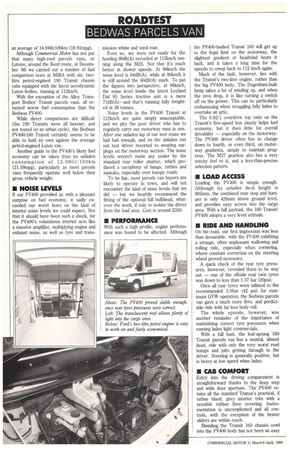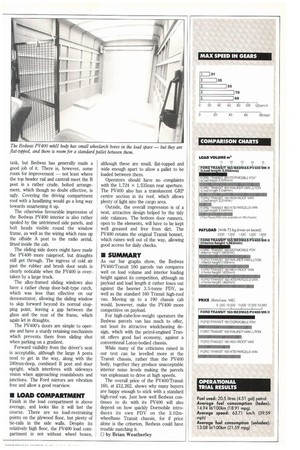ROADTEST BEDVVAS PARCELS VAN
Page 50

Page 51

If you've noticed an error in this article please click here to report it so we can fix it.
an average of 14.941it/1001cm (18.91mpg).
Although Commercial Motor has not put that many high-roof parcels vans, or Lutons, around the Kent route, in December '86 we carried out a number of fuel comparison tests at MIRA with six, twolitre petrol-engined 190 Transit chassis cabs equipped with the latest aerodynamic Luton bodies, running at 112km/h.
With the exception of the Alloy Transport Bodies' Transit parcels vans, all returned worse fuel consumption than the Bedwas PV400.
While direct comparisons are difficult (the 190 Transits were all heavier, and not tested on an urban cycle), the Bedwas PV400/160 Transit certainly seems to be able to hold its own against the average petrol-engined Luton van.
Another guide to the PV400's likely fuel economy can be taken from its unladen consumption of 1 3.0 8lit/1 0 Okm (21.59mpg), particularly as most parcels vans frequently operate well below their gross vehicle weight.
• NOISE LEVELS
If our PV400 provided us with a pleasant surprise on fuel economy, it sadly exceeded our worst fears on the kind of interior noise levels we could expect. Not that it should have been such a shock, for the PV400's voluminous interior acts like a massive amplifier, multiplying engine and exhaust noise, as well as tyre and trans Even so, we were not ready for the howling 90db(A) recorded at 1121un/h running along the M25. Not that it's much better at slower speeds. At 96Iun/h the noise level is 84dB(A), while at 801crnth it is still around the 80dB(A) mark. To put the figures into perspective, at 96km/h, the noise level inside the latest Leyland Daf 95 Series tractive unit is a mere 71dB(A)—and that's running fully freighted at 38 tonnes.
Noise levels in the PV400 Transit at 112kmAi are quite simply unacceptable, and we pity the poor driver who has to regularly carry out motorway runs in one. After one unladen lap of our test route we had had enough, and on the unladen run out test driver resorted to wearing earplugs on the motorway section. The noise levels weren't made any easier by the standard rear roller shutter, which produced a cacophony of bangs, rattles and squeaks, especially over bumpy roads.
To be fair, most parcels van buyers are Likely to operate in town, and will not encounter the kind of noise levels that we did — but we heartily recommend the fitting of the optional full bulkhead, whatever the work, if only to isolate the driver from the load area. Cost is around £350.
• PERFORMANCE
With such a high profile, engine performance was bound to be affected. Although the PV400-bodied Transit 160 will get up to the legal limit on the motorway, the slightest gradient or headwind beats it back, and it takes a long time for the speedo to creep back to 112 km/h again.
Much of the fault, however, lies with the Transit's two-litre engine, rather than the big PV400 body. The Dagenham-built lump takes a lot of winding up, and when the revs drop, it is like turning a switch off on the power. This can be particularly embarassing when struggling fully laden to overtake an artic.
The 0.82:1 overdrive top ratio on the Transit's five-speed box clearly helps fuel economy, but it does little for overall drivability — especially on the motorway. The PV400 driver often has to change down to fourth, or even third, on motorway gradients, simply to maintain progress. The M27 gearbox also has a very notchy feel to it, and a less-than-precise selection pattern.
• LOAD ACCESS
Loading the PV400 is simple enough. Although its unladen deck height is 805mm, the combined rear step and bumper is only 428mm above ground level, and provides easy access into the cargo area. With a full payload, the 160 Transit/ PV400 adopts a very level attitude.
• RIDE AND HANDLING
On the road, our first impression was less than favourable, with the PV400 exhibting a strange, often unpleasant wallowing and rolling ride, especially when cornering, where constant correction on the steering wheel proved necessary.
A quick check of the rear tyre pressures, however, revealed them to be way out — one of the offside rear twin tyres was down to less than 1.37 bar (20psi).
Once all rear tyres were inflated to the recommended 2.9bar (42 psi) for maximum GVW operation, the Bedwas parcels van gave a much more firm, and predictable ride with far less body roll.
The whole episode, however, was another reminder of the importance of maintaining correct tyre pressures when running laden light commercials.
With a full load, the leaf-sprung 160 Transit parcels van has a neutral, almost dead, ride with only the very worst road bumps and jolts getting through to the driver. Steering is generally positive, but is heavy at low speed when laden.
• CAB COMFORT
Entry into the driving compartment is straightforward thanks to the deep step and wide door aperture. The PV400 retains all the standard Transit's practical, if rather bland, grey interior trim with a sensible rubber floor covering. Instrumentation is uncomplicated and all controls, with the exception of the heater sliders are within reach.
Blending the Transit 160 chassis cowl into the PV400 body has not been an easy task, but Bedwas has generally made a good job of it. There is, however, some room for improvement — not least where the top header rail and cantrail meet the B post in a rather crude, bolted arrangement, which though no doubt effective, is ugly. Covering the driving compartment roof with a headlining would go a long way towards smartening-it up.
The otherwise favourable impression of the Bedwas PV400 interior is also rather spoiled by the untrimmed side panels, and bolt heads visible round the window frame, as well as the wiring which runs up the offside A post to the radio aerial, fitted inside the cab.
The sliding side doors might have made the PV400 more rainproof, but draughts still get through. The ingress of cold air past the rubber and brush door seals is clearly noticable when the PV400 is overtaken by a large truck.
The alloy-framed sliding windows also have a rather cheap door-bolt-type catch, which was less than effective on our demonstrator, allowing the sliding window to skip forward beyond its normal stopping point, leaving a gap between the glass and the rear of the frame, which again let in draughts.
The PV400's doors are simple to operate and have a sturdy retaining mechanism which prevents them from sliding shut when parking on a gradient.
Forward visibility from the driver's seat is acceptable, although the large A posts tend to get in the way, along with the 240mm-deep, combined B post and door upright, which interferes with sideways vision when approaching roundabouts and junctions. The Ford mirrors are vibration free and allow a good rearview.
• LOAD COMPARTMENT
Finish in the load compartment is above average, and looks like it will last the course. There are no load-restraining points on the plywood floor, but plenty of tie-rails in the side walls. Despite its relatively high floor, the PV400 load compartment is not without wheel boxes, although these are small, flat-topped and wide enough apart to allow a pallet to be loaded between them.
Operators should have no complaints with the 1,724 x 1,535rnm rear aperture. The PV400 also has a transluscent GRP centre section in its roof, which allows plenty of light into the cargo area.
Outside, the overall impression is of a neat, attractive design helped by the tidy side valances. The bottom door runners, open to the elements, will have to be kept well greased and free from dirt. The PV400 retains the original Transit bonnet, which raises well out of the way, allowing good access for daily checks.
• SUMMARY
As our bar graphs show, the Bedwas PV400/Transit 160 parcels van compares well on load volume and interior loading height against its competition, although on payload and load length it rather loses out against the heavier 3.5-tonne PDV, as well as the standard 160 Transit high-roof van. Moving up to a 190 chassis cab would, however, make the PV400 more competitive on payload.
For high-cube/low-weight operators the Bedwas parcels van has much to offer, not least its attractive windcheating design, which with the petrol-engned Transit offers good fuel economy, against a conventional Luton-bodied chassis.
While many of the criticisms raised in our test can be levelled more at the Transit chassis, rather than the PV400 body, together they produce unacceptable interior noise levels making the parcels van unpleasant to drive at high speeds.
The overall price of the PV400/Transit 160, at 212,262, shows why many buyers are happy enough to stick with a standard high-roof van. Just how well Bedwas continues to do with its PV400 will also depend on how quickly Dormobile introduces its own PDV on the 3.02mwheelbase Transit chassis, for if price alone is the criterion, Bedwas could have trouble matching it.
LI by Brian Weatherley
















































































































































